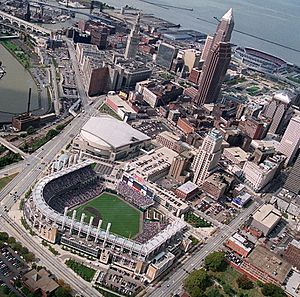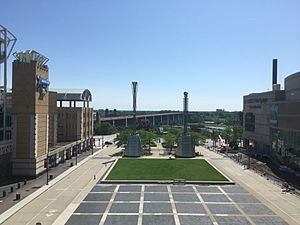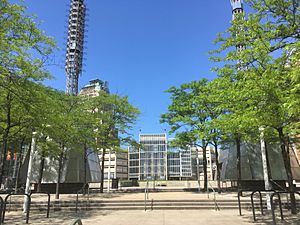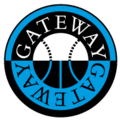Gateway Sports and Entertainment Complex facts for kids
The Gateway Sports and Entertainment Complex is a big sports and fun area in downtown Cleveland, Ohio. It opened in 1994. The city of Cleveland and Cuyahoga County own it. A non-profit group called the Gateway Economic Development Corporation manages it. Leaders from the city and county pick the people who run this group.
The complex has two main parts. One is Progressive Field, a baseball park with 35,051 seats. It's the home of the Cleveland Indians baseball team. The other is Rocket Mortgage FieldHouse, an arena with 19,432 seats. This is where the Cleveland Cavaliers basketball team plays. The complex also has an open area called Gateway Plaza and a large parking garage.
Gateway is located near East 9th Street, Huron Road, Ontario Street, and Carnegie Avenue. It's a key part of the larger Gateway District in downtown Cleveland.
Contents
What You'll Find Here
The two main buildings at Gateway are connected to Tower City Center and the RTA Rapid Transit train system. You can get there through an underground walkway.
Progressive Field: Home of Baseball
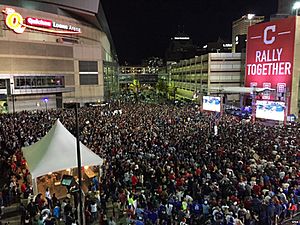
Progressive Field was the first part of the complex to open. It started on April 4, 1994, and was first called Jacobs Field. Building it cost about $175 million. The owner of the Indians team, Richard Jacobs, paid about half of this cost. The rest came from a special 15-year tax.
The stadium was designed by a company called HOK Sport (now Populous). They made it a "retro-modern" ballpark. This means it looks classic but has modern features. It has fences of different heights and a smaller upper deck. The stadium was built so that you could see Cleveland's downtown buildings from inside.
Rocket Mortgage FieldHouse: Home of Basketball
Rocket Mortgage FieldHouse opened on October 17, 1994. It was first named Gund Arena and later Quicken Loans Arena. It's a very large building, about 480 feet long and 440 feet wide. It was designed by Ellerbe Becket Sports & Venue and a local firm.
Like the baseball park, the arena also offers views of the city. It has a large bay window that looks out towards the city's industrial area called The Flats. The underground area can fit 26 tour buses. This arena cost about $152 million to build.
Gateway Plaza: The Outdoor Space
Gateway Plaza is an open area between Rocket Mortgage FieldHouse and Progressive Field. It's mostly a concrete road but has some cool art and green spaces. On game days, you'll often see TV and radio shows broadcasting live from here. It's also used for other events related to games. For example, some events for the 1997 MLB All-Star Game Fan Fest happened in Gateway Plaza.
Parking Garages
The complex has two large parking garages that can hold 3,300 cars together.
The Jack Parking Garage is on the north side. It used to be called Gateway North garage. It has entrances on Ontario Street and High Street. There used to be a walkway connecting it to Rocket Mortgage FieldHouse, but it was removed in 2018. In 2013, another walkway was built to connect it to the Jack Cleveland Casino. The city also built a downtown bike station here in 2011. The casino now manages this garage, but it's still used for events at Gateway.
The Gateway East garage is between Rocket Mortgage FieldHouse and Progressive Field. It has two walkways that connect to the arena and the ballpark. The main entrance is on Huron Road. This garage is managed by Standard Parking.
How Gateway Was Built
Early Ideas for a Stadium
The idea for the Gateway complex started in the early 1980s. Cleveland wanted the Cavaliers basketball team to come back to the city. Also, the Browns football team and Indians baseball team were playing at Cleveland Stadium. This old stadium was costing the city a lot of money. Cleveland hadn't built a major sports building since 1937.
People first thought about building a large dome stadium. This dome would be home to the Browns and Indians and bring the Cavaliers back. This idea was like the Pontiac Silverdome in Michigan. But in 1984, people voted against the idea of a $150 million dome stadium. Another dome idea came up in 1985, but it was never built. This new idea suggested paying for it with a special tax on alcohol and cigarettes.
Even with these setbacks, city and state leaders kept pushing for a new sports complex. They borrowed money and started buying land in 1985. By 1989, old buildings were torn down to make way for the project. But there were still disagreements about who would pay for everything.
The Vote for Issue 2
In 1990, new leaders took over the project. This group included Cleveland's mayor, Michael R. White, and county leaders. They quickly planned to pay for the complex with a 15-year special tax on alcohol and cigarettes in the county. This tax was put on the May election ballot as "Issue 2." They hoped it would pass because fewer people usually vote in primary elections.
There was a lot of advertising for and against Issue 2. At the same time, there was a 1990 Major League Baseball lockout (a strike by players). This made it harder for smaller teams like the Indians to make money. Just before the vote, the baseball commissioner said that if Issue 2 didn't pass, there could be problems for the team.
These things led to many people voting. On May 8, 1990, Issue 2 passed by a small margin. A month later, the Gateway Economic Development Corporation was created to build the complex. Both the baseball park and the arena were finished in 1994.
Images for kids


